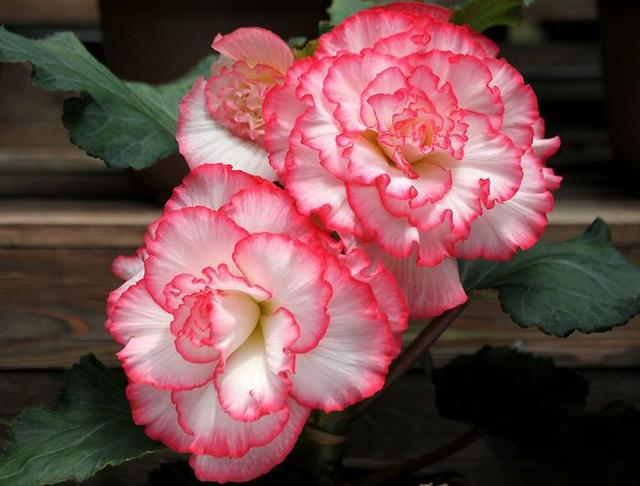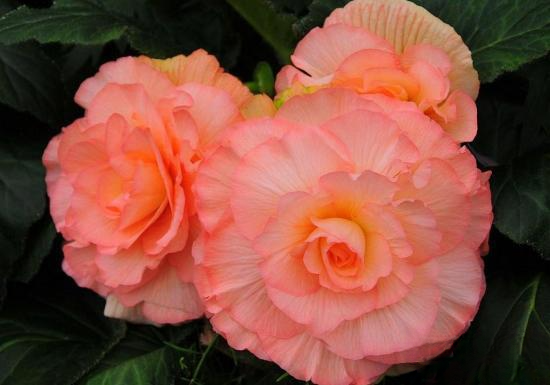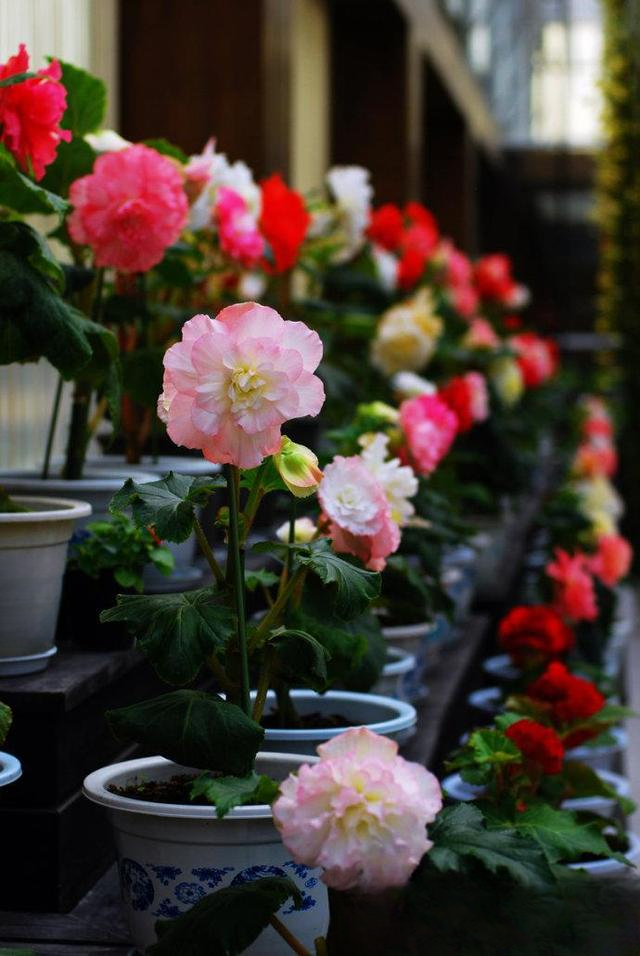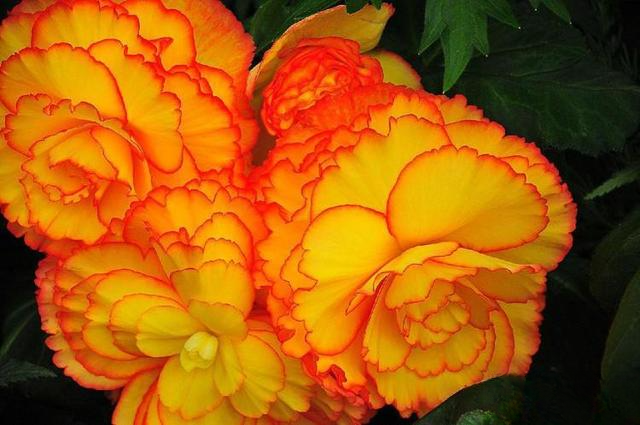The bulb propagation technology of Begonia bulbs
The bulb propagation technology of Begonia bulbs
The cultivation of bulbous begonia has a long history. Now, European and American countries have realized industrialized cultivation and are widely used in potted plants, courtyards and engineering landscaping. With the development of domestic home gardening industry and leisure agriculture industry, the demand for bulbous begonia has increased significantly. However, due to the unique production characteristics of bulbous begonia and the imperfections of various links in production technology, the actual production volume is not large at present.

Reproduction
Begonias are divided into four-season begonias, Rieger begonias and bulbous begonias. Rieger begonias are mostly propagated by cuttings, with a small amount of seed propagation. Bulbous begonias are mostly propagated by seeds, and cuttings are also used, but they are less used. Bulb propagation is mainly concentrated in professional bulb companies in Europe and the United States.
Seed propagation is a conventional method for producing bulbous begonias, but it is more often used by professional producers, and amateurs are basically unlikely to operate it. The main reasons are: First, it has high requirements for facilities and strong production technology. In particular, the seed breeding of bulbous begonias takes a period of 2 to 3 months. Even for professional companies, problems will arise if they are not careful. Second, the production cycle is long and the season span is large. From sowing to flowering, it takes about 5 to 8 months to go through the stages of sowing, seedling breeding, large seedling planting, and potted flower breeding. The long breeding cycle leads to a large seasonal span. Since bulbous begonias are long-day plants, the flowering period of bulbous begonias propagated by seeds is mostly from June to August. During this period, most parts of the country are in summer, and sales, maintenance and application are facing problems. Third, the number of flowers is limited. Propagating bulbous begonias by cuttings can shorten the production cycle by 1 to 2 months, but it also faces three problems: there must be a mother garden, and the cuttings must be specialized; the number of finished flowers is limited; it can only be used for potted flower production and cannot be used directly in gardens and engineering landscaping.
The use of bulb production and breeding can solve the problem of seed propagation and seedling cutting propagation. On the one hand, it can shorten the production cycle and facilitate year-round production. On the other hand, the number of flowers is large and the product quality is high. In addition, it has two other advantages: both the finished product and the seedlings of the bulbous begonia are not resistant to transportation, so the production radius is very small. Bulb production is very suitable for family consumption; the bulbs can be planted directly in the ground and are widely used in parks, green spaces, gardens or leisure agriculture industries.

Factory breeding of seedlings
At present, the domestic production of bulbous begonia bulbs is extremely scattered and the quality of the bulbs is unstable. Most of the bulbs are mainly imported from abroad, which is relatively costly. Moreover, the imported bulbs are across a large area, the bulbs are easy to rot, and there is also the risk of quarantine pests and diseases. At present, the companies in the world that commercially produce and breed bulbous begonias are concentrated in countries such as the Golden State Bulb Company in the United States and the Netherlands. The natural climate conditions here are extremely superior. The land is peat soil, the summer is cool, the winter is warm, the sunlight is sufficient but not strong, and the air humidity is high. The technology similar to that of potato cultivation is completely adopted to breed bulbs in large quantities in the open field. However, there is basically a lack of similar natural climate conditions in China for breeding bulbous begonia bulbs. Therefore, it is particularly important to reasonably use the domestic natural climate conditions to breed bulbs.
The weight of common seeds of bulbous begonia is 70,000 per gram, and the weight of pellet seeds is 1,000 per gram. You can use a 200-hole or 288-hole tray for sowing. Use imported fine peat moss and add 20% of 3-5mm large-grain perlite. After the mixed substrate is loaded into the tray, water the substrate thoroughly and drain it before sowing. Be careful not to cover the seeds.
The seedling raising cycle is divided into four stages: the first stage is carried out in the germination room, the temperature is 22℃~24℃, it takes 7~10 days, the substrate should be kept moist, the air humidity is preferably 100%, and full light is required in this stage. After the seeds begin to germinate, they enter the second stage of management. During this period, they are taken out of the germination room and moved to the greenhouse for management. The temperature is 21℃~22℃, and shade is required. Fertilizers can be applied once a week, and fertilizers with a ratio of N∶P∶K of 15∶0∶15 and 20∶10∶20 are used alternately, with a concentration of 50~75ppm, which takes 14~21 days. During this period, water needs to be sprayed regularly to keep the substrate moist. The temperature of the third stage is 20℃, the fertilizer concentration is 100~150ppm, and fertilizer is applied twice a week, which takes 35~42 days. At this time, the plant can basically reach 4 leaves and 1 heart. The temperature in the fourth stage is 15℃~17℃, it takes 7 days, and the fertilizer concentration is the same as the third stage.
After completing the four stages of the seedling cycle, you can plant in a 32-hole tray or a 12cm×10cm small flower pot. Begonia bulbosa is a shallow-rooted plant, and the best potting medium is loose and breathable Northeast peat or imported peat. Keep the potting soil moist during the growing period. Use 20:20:20 general fertilizer and fertilize once every half month.
Selection and construction of bulb breeding base
Choose the right forest land. In the Yangtze River Basin, choose high mountain forest land with an altitude of 600 to 1200m. The most ideal natural forest tree species is pine forest. For artificial forest land, it is better to have continuous crowns and trees about 5m high, and it is better to be sparse. As long as it is easy to operate, the slope of the forest land can be between 20° and 65°. The soil quality is preferably selected with deep humus, rich in organic matter, loose on the top and solid on the bottom. It is not advisable to choose heavy yellow mud and white eel soil.
Arrange the shade shed For natural forests, all dead branches, shrubs, and thatch should be cut off, and small branches below 3m from the ground should be trimmed, and the shade degree should be maintained at 60% to 75%. For artificially cultivated forests, it is basically sufficient to have branches connected. If there are skylights in some places, simply use branches to provide semi-shading.
Land preparation and ridge making Before land preparation, use a wooden rake to rake the dead branches, fallen leaves and stones on the topsoil out of the forest. The bamboo roots, small tree roots and thatch roots in the forest should be removed. Try not to damage the tree roots when digging, and avoid deep digging. For artificially cultivated forests, only shallow digging is required once, and weed roots and stones are picked out. If there is a lack of soil around the trees, soil should be added, and the roots should not be exposed. Dig trenches to make ridges. Dig straight trenches from top to bottom, with a width of 23cm and a depth of 10cm. The soil at the bottom of the trenches is lifted and placed on the ridges on both sides.

Bulb cultivation and maintenance
After the root system of the bulbous begonia 32 holes is complete, it can be transplanted to the forest. When planting bulbous begonia 32 hole seedlings, straighten the seedlings and add more soil, then gently lift the seedlings to allow the roots to stretch naturally, then cover them tightly with soil and water them sufficiently. The planting depth is such that the short stems at the top of the cuttings at the top of the original seedling hole tray are just buried in the soil, cover the soil and compact it, and then water it once for rooting. The first watering after planting is called rooting water, which must be watered thoroughly.
Planting is done in the morning or evening on cloudy or sunny days. Planted seedlings are covered with covering materials to retain water, prevent freezing and prevent weed growth. Covering materials are selected from pine needles, medicinal residues, mushroom residues, straw, weeds or dead leaves. Preferably, the covering material is selected from ground pine needles and medicinal residues.
During the cultivation of bulbs, weeds need to be removed in time. If individual plants have flower buds, remove them as soon as possible. Where conditions permit, apply water-soluble fertilizers with a ratio of N:P:K of 1:1:1 every week. The fertilizer concentration can be 0.1% to 0.2%.
During the growing season (June to August), when the environment is hot, humid and poorly ventilated, stem rot and root rot often occur. The room temperature and watering amount should be controlled. Water with 1000 times dilution of carbendazim wettable powder or 1000 times dilution of benomyl every 15 to 30 days.
Under high temperature conditions, bulbous begonias are vulnerable to pests such as aphids, leaf roller larvae and thrips. Aphids live in groups on petioles, flower buds and new shoots to absorb nutrients and bite flowers and leaves. Thrips absorb nutrients from the back of leaves. Scale insects can be sprayed with 1000 times diluted 40% omethoate EC. Leaf rollers can be sprayed with 2000 times diluted 10% pyrethrin EC and dertensin. Thrips can be sprayed with 4000 times diluted potassium permanganate. Avoid excessive moisture for a long time, otherwise it will hinder the growth of stems and leaves and cause tuber rot. If the leaves are light green, it means lack of fertilizer. If the leaves are light blue and curled, it means too much nitrogen fertilizer, and the amount of fertilizer should be reduced or the interval between fertilization should be extended.
It is possible that high temperature and insufficient light in some areas may cause the plants to grow too tall. Usually, 250ppm of CCC is sprayed once every 7 to 10 days.
Bulb harvesting and storage
When the temperature drops below 5℃, the bulbous begonia stops growing and enters a dormant period. At this time, you can cut off the above-ground part, dig out the bulbs, dry them slightly, and store them in a cold room. If there are fewer plants, you can also leave them in the pots, cover them with fine sand, keep the pot soil slightly moist, and store them in a ventilated and dry place indoors. The storage temperature should be 5℃ to 8℃, and the lowest should not be lower than 2℃, otherwise the bulbs will be easily damaged by cold.
